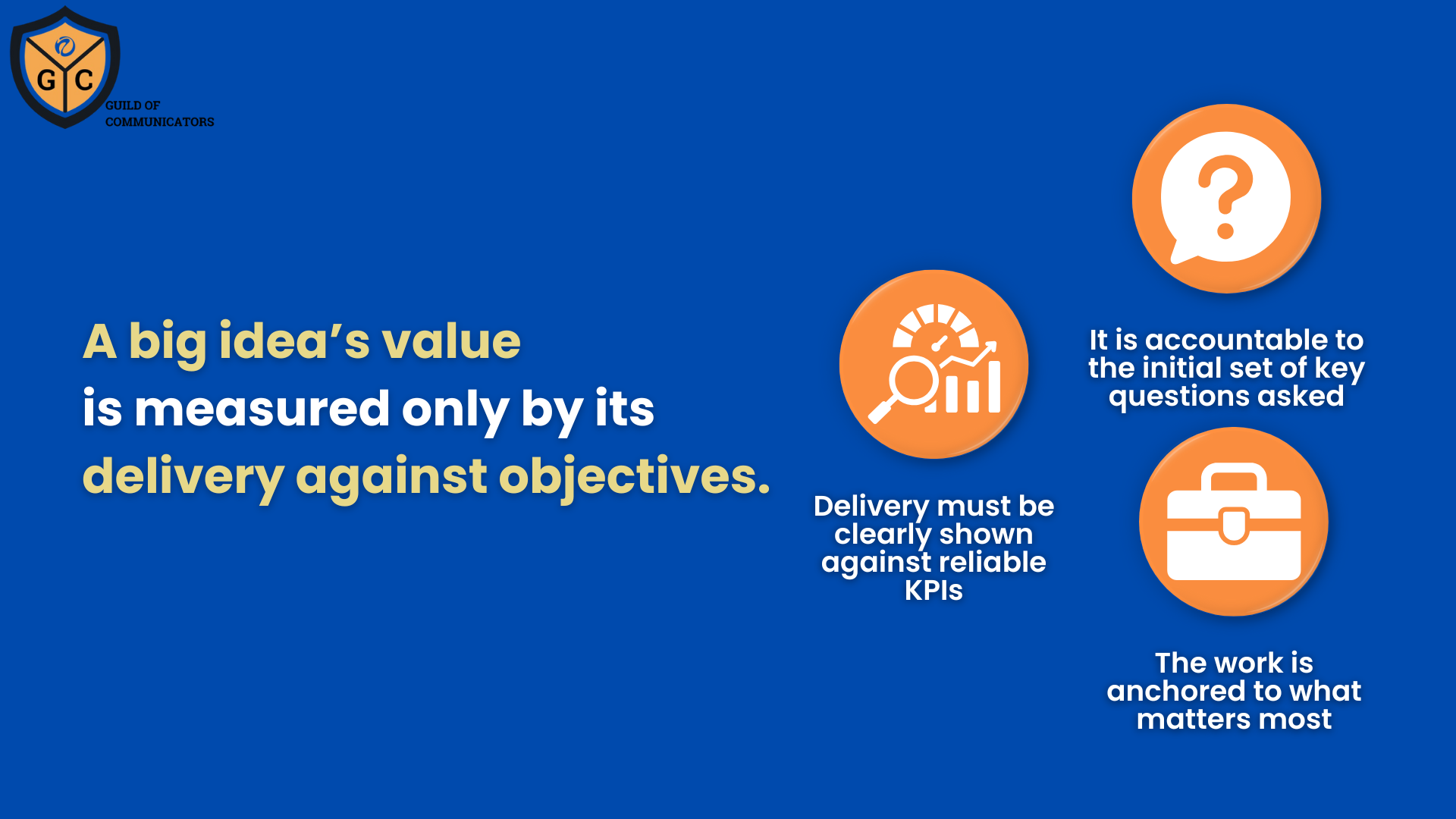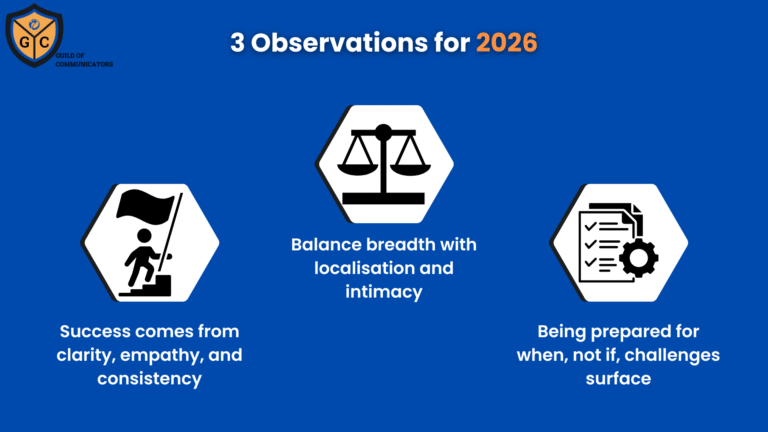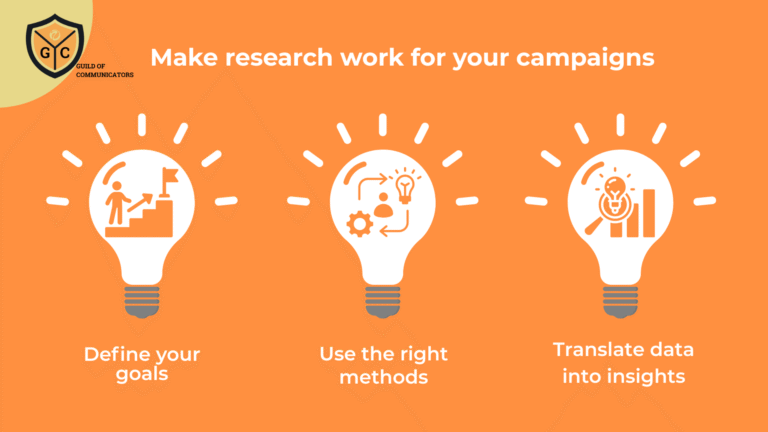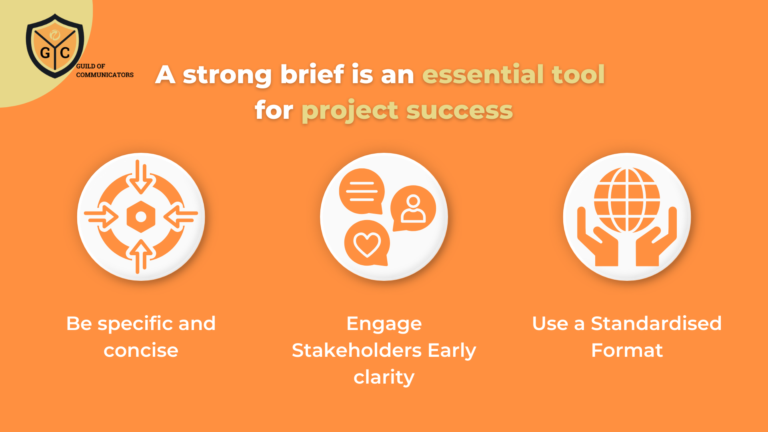Big ideas are meant to drive attention and engagement.
Without clear objectives and meaningful KPIs, they can become distractions rather than strategic assets. A concept that looks impressive on the surface is not necessarily useful if it fails to support the communicator’s purpose.
For communicators and their teams, that are under pressure to deliver results, it’s tempting to believe a big idea is an end in itself. But a strong concept is only valuable when it serves the broader goals of a campaign, programme, or organisational strategy.
The real measure of success lies not in how creative or catchy the idea is—but in whether it helped achieve the right outcome, for the right audience, at the right time.
Big Ideas Are Not Stand-ins for Value
When asked to demonstrate value, many communicators turn to big ideas to show initiative, ambition, and reach. The thinking is clear: if something is bold, visible, and wide-reaching, it must be working.
But scale alone does not equal value.
An idea can attract attention and still miss the mark if it does not result in meaningful engagement or measurable progress against a defined objective.
Big ideas should not be used as shortcuts to prove value. They must be designed to work for specific outcomes. Otherwise, they risk becoming expensive activities with little strategic return.
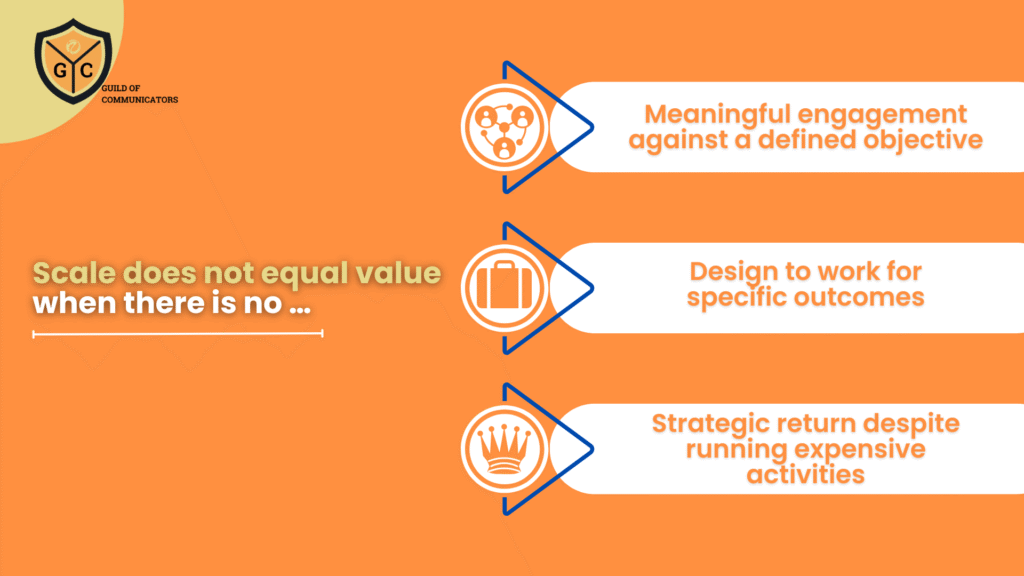
You Can Hit the Target and Still Miss the Centre
Leadership, particularly those with a short-term focus or those less familiar with communication nuances, might find big ideas particularly appealing because they often appear to come with a wide array of potential measurement points. It is relatively easy to generate many data points from a large-scale campaign, such as social media impressions, website visits, or media mentions, creating an appearance of significant activity and broad reach.
However, these “vanity metrics” or superficial data points can be misleading if they are not directly tied to strategic objectives. A flurry of activity or high numbers in certain areas does not automatically equate to success if the underlying goals, such as changing specific perceptions or driving qualified leads, are not being met. This can create a dangerous illusion of progress.
It is possible to deliver strong numbers and still miss the actual communication goal.
A big idea must be judged by whether it supported the intended result. For example, a campaign that creates awareness but fails to move audiences to take the next step whether that is participation, adopting a behaviour, or changing perception does not meet its purpose.
Connect the Big Idea to the Right Targets
Because of their scale and scope, big ideas must be tightly aligned to specific objectives and KPIs. Otherwise, it becomes difficult to evaluate whether the work succeeded or failed.
Without this fundamental connection, big ideas risk becoming detached from any strategic purpose, turning into creative exercises rather than business drivers.
Objectives describe what the campaign needs to achieve. They may be about awareness, knowledge, attitude, participation, or action. KPIs are the indicators used to measure whether the objective has been met.
The best way to ensure a big idea is connected to its purpose is to reverse-engineer from the outcome. Start by identifying what the organisation or client needs to achieve, then work backward to design an idea that enables that outcome.
Accountability Builds Credibility
When a big idea is tied to clear objectives and measured using the right KPIs, the communicator gains more than just insight—they gain credibility.
Vague or surface-level metrics do little to help teams learn what worked and what didn’t. But when the communicator can demonstrate alignment between the idea, the outcome, and the evidence of impact, the value of their work becomes clearer to stakeholders.
It demonstrates strategic thinking, responsible stewardship of resources, a clear focus on delivering what the organisation needs, and an ability to translate creative concepts into tangible, beneficial results.
This builds trust, both in the communicator’s strategic thinking and their ability to contribute to organisational goals. It also helps strengthen the case for future investment in communication programmes.
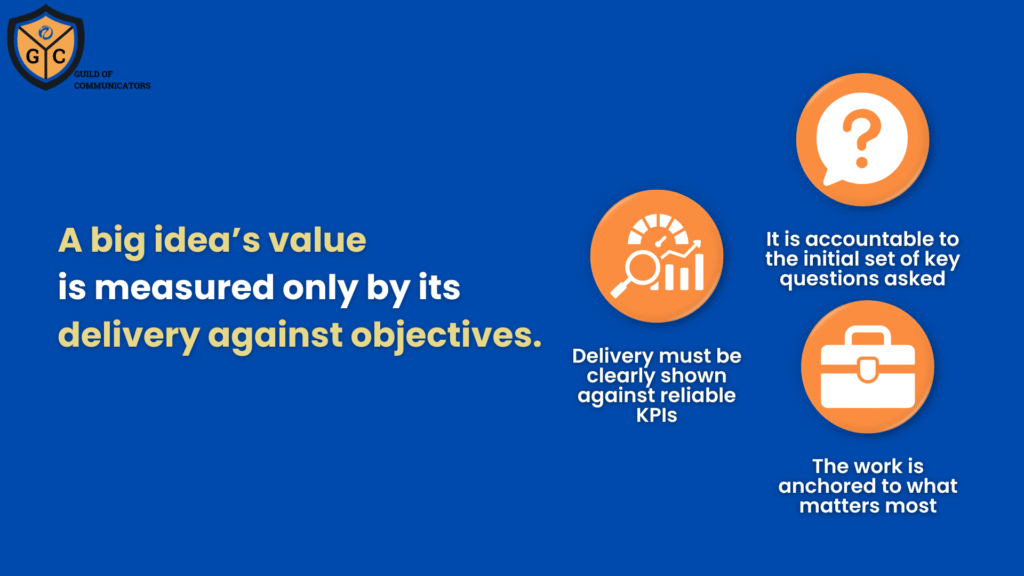
Two Sets of Questions to Ask from the Start
A big idea should never be judged by visibility alone. Its real value lies in how well it delivers on the defined objectives—and how clearly that delivery can be shown through reliable KPIs.
The best way to make a big idea accountable is to start by asking the right questions before the concept is even developed. This ensures that the work stays anchored to what matters most.
To determine the right objectives, ask:
- What is the change we are trying to create with this campaign or programme?
- How does this specific change align with broader business goals or the organisation’s overarching mission and strategic priorities? Where is the clear link?
- Who needs to take action, change perception, or learn something?
- What will success look like if we achieve this outcome?
- If we successfully achieve this objective, what tangible and demonstrable value will it bring to the business (e.g., increased sales, improved reputation, better employee retention)?
- Is this objective S.M.A.R.T. (Specific, Measurable, Achievable, Relevant, Time-bound)? If not, how can we refine it to meet these criteria?
To determine the right KPIs, ask:
- What evidence will show that the audience moved in the desired direction?
- What behaviours, patterns, or decisions can we track or observe?
- What timelines and checkpoints will help us assess progress? For each stated objective, what precise data points will definitively and reliably indicate that we are making progress towards it?
- What are the current baseline figures for these metrics, if available and relevant? Without a baseline, how will we accurately gauge the extent of change?
- What specific, quantifiable targets for each KPI will signify success within the campaign’s timeframe? Are these targets ambitious yet realistic?
- Are these KPIs direct indicators of the objective’s achievement, or are they proxy measures (indirect indicators)? If they are proxies, how strong and reliable is the link to the actual objective?
When these two sets of questions are used together, the communicator is better positioned to create ideas that are not only bold and creative but purposeful and measurable.
Communicators should see big ideas not just as creative outputs, but as strategic tools. When used properly, they help the communicator achieve goals, build trust, and show the impact of their work in practical terms.
*****
Join the Guild of Communicators at www.gocommunicators.com.
The Guild of Communicators (Go Communicators) stands as the preferred community for communicators seeking to elevate their craft. Through our Academy of Excellence, we provide best-in-class frameworks, fit-for-purpose resources, and opportunities that support members in achieving professional excellence.
We provide the following resources, tools and opportunities to members:
- Best-in-Class Resources: We provide our members with access to frameworks, playbooks and tools that empower them to achieve and maintain professional excellence.
- Continuous Learning and Growth: Through our comprehensive training programmes, workshops, delivered digitally, 24/7 and in-person, we support the ongoing professional development of communicators.
- A Supportive Network: GOC fosters a vibrant community where communicators can connect, collaborate, and support each other, creating a network that champions mutual growth and success.
- Shared Knowledge and Expertise: Our members benefit from the collective wisdom and experience of a diverse group of communication professionals, enhancing their skills and perspectives.
Go Communicators is dedicated to amplifying the impact and value that communicators bring to their organisations, highlighting their crucial role in driving success and growth.
We equip our members with the strategies and tools needed to become influential leaders and business partners within their organisations, enhancing their ability to drive positive change and outcomes.
Through our support and resources, communicators can demonstrate clear, measurable outcomes that showcase their value and impact, reinforcing their importance to their organisations.
Join the Guild of Communicators at www.gocommunicators.com
Subscribe to join over 1500+ communicators and brands getting value every Tuesday while reading A Communicator’s Perspective, our weekly newsletter.

